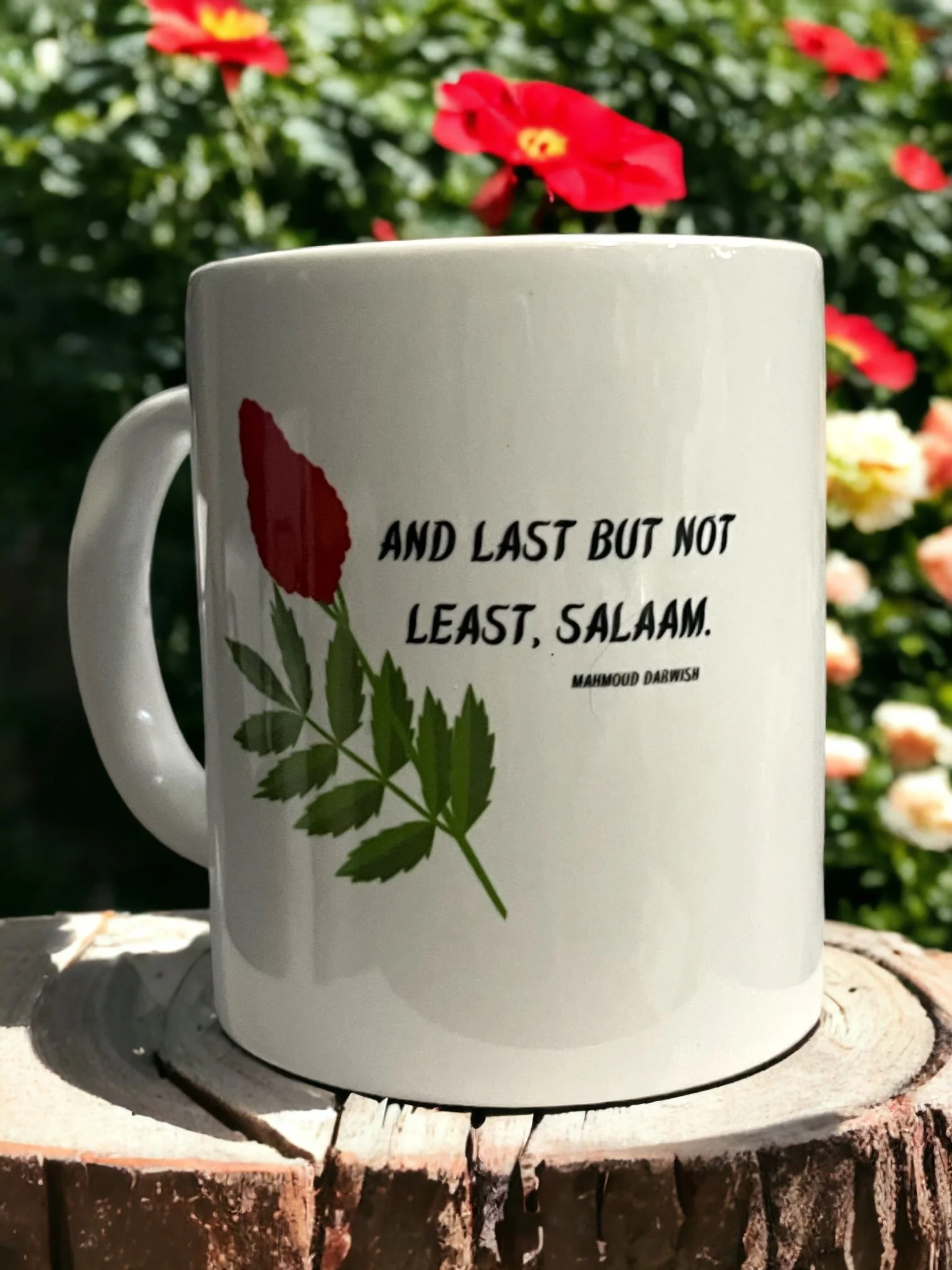Solidaritea
This product idea was developed in conversation with Rochester Witness for Palestine, organizers of the Witness Palestine Film Festival, and will be sold as a fundraiser for them with their blessing: a minimum of 50% of all proceeds (not just profits) from the sale of this tea and mug set will go directly to them.
IN THIS POST:
Product Description
Ingredient Actions and Contraindications
References
Product Description
I don't know if I have ever put so much love and intention into developing a tea blend before.
The recipe for this bold, flavorful tea blend was intentionally created as a representation of international solidarity for a free Palestine. Irish Breakfast tea represents the longstanding solidarity between Ireland and Palestine and their enduring commitment to end colonialism.
The traditional spices used in baharat (smoked paprika, cumin, black pepper, coriander, nutmeg, cinnamon, cardamom, and cloves) are accompanied by other flavors that provide Palestinian cuisine with the life, heart, and nuance that it is known for (by those who have been lucky enough to eat it): sumac, mint, licorice root (see: erk sous!), lemon balm, and sage.
Close-up of the tea blend
The sumac used in this tea blend is Rhus typhina (aka staghorn sumac), a plant that is native to the eastern United States and which grew right here at The Wild Within Acres. In an act of biological solidarity, Rhus typhina is such a close relative of the species of sumac that is native to Palestine (Rhus coriaria) that it can be used interchangeably both culinarily and medicinally (Trusov et al., 2021). The purple sage used in this blend was also grown right here at The Wild Within!
In one final layer of solidarity incorporated into this tea blend, the lemon balm was grown by a friend of The Wild Within Acres, adding an overt aspect of community and connection!
The mug includes the closing line from Mahmoud Darwish’s poem “To a Young Poet” as translated by Fadi Joudah—"And last but not least, Salaam"—alongside an image of sumac leaves and flowers.
This tea and mug set will be available at the Queer Handmade Holiday Sale tomorrow (11/12), 10a-4p at Allendale Columbia School (14618) and our other winter vending events, as well as through our website, for $25.
Directions:
Use 2-5 g loose tea (approx. 1-2 teaspoons) per 250-500 mL (approx. 1-2 cups) of hot water (80-90 degrees C/175-200 degrees F) for 5-10 minutes.
The ranges account for different preferences in the strength, astringency, and bitterness of the resultant tea: higher ratios of tea to water create a stronger tea, while longer brewing times create a tea with more astringency and bitterness.
Ingredients:
Irish Breakfast tea, staghorn sumac berries*, peppermint leaves, green cardamom seeds, licorice root, cumin seeds, lemon balm leaves and flowers**, smoked paprika, black peppercorns, coriander seeds, black cardamom seeds, purple sage leaves*, cloves, nutmeg seed.
*Grown at Wild Within Acres; **Grown by a friend of Wild Within Acres
Ingredient actions and contraindications***
A dictionary of herbal actions can be found at Terminology (herbalgram.org).
Staghorn Sumac (Rhus typhina):
Herbal Actions:
Antioxidant, antiviral, antibacterial, antifibrogenic, antifungal, anti-inflammatory, antimalarial, antimicrobial, antimutagenic, chondroprotective, hepaprotective, cytotoxic, anti-ischemic, antithrombotic, vasorelaxant, hypoglycemic, and leukopenic (Batiha et al., 2022; Martinelli et al., 2022; Rayne & Mazza, 2007; Sakhr & El Khatib, 2020; Trusov et al., 2021).
Contraindications:
As is true for many culinary herbs, staghorn sumac and Mediterranean sumac have few known contraindications. They are in the Anacardiaceae family (i.e., cashew family), so those with allergies to plants within this family should exercise caution.***
Peppermint (Mentha × piperita):
Herbal Actions:
Carminative, anti-inflammatory, antispasmodic, aromatic, diaphoretic, antiemetic, nervine, antimicrobial, analgesic (Hoffman, 2003).
Contraindications:
No side effects, drug interactions, or contraindications are known, unless in the presence of allergies to members of the mint family (Hoffman, 2003).***
Cardamom (Green: Elettaria cardamomum and Black: Amomum subulatom Roxburgh):
Herbal Actions:
Anti-inflammatory, antivenomous (for some snake and scorpion venoms), hepatoprotective, anti-ulcerogenic (Rajathiet al., 2017).
Contraindications:
No side effects, drug interactions, or contraindications are known.***
Licorice (Glycyrrhiza glabra):
Herbal Actions:
Expectorant, demulcent, anti-inflammatory, antihepatotoxic, antispasmodic, anti-ulcerogenic, mild laxative (Edwards, 2015 and Hoffman, 2003).
Contraindications:
“Side effects are minimal if daily intake is less than 10 mg of glycyrrhizin…. Prolonged use in conjunction with thiazide and loop diuretics and cardiac glycosides is contraindicated, and licorice should not be administered in combination with spironolactone or amiloride. This herb is not recommended for patients taking cardiac glycosides, hypotensive agents, corticoids, diuretic drugs, or monoamine oxidase inhibitors” (Hoffman, 2003).
“Not recommended in patients suffering from hypertension, hypokalaemia, kidney disease, liver or cardiovascular disorders. Liquorice extracts in high doses should be avoided in pregnancy and lactation and are not recommended in children and adolescents under 18 due to lack of data” (Edwards, 2015).***
Cumin (Cuminum cyminum):
Herbal Actions:
Antioxidant, antiepileptic, antimicrobial, antispasmodic, digestive bitter, carminative, chemoprotective, emmenagogic, hypoglycemic, hypolipidemic, (Azeez, 2008).
Contraindications:
No side effects, drug interactions, or contraindications are known.***
Lemon Balm (Melissa officinalis):
Herbal Actions:
Nervine, carminative, antispasmodic, antimicrobial, antidepressant, diaphoretic, hepatic (Hoffman, 2003).
Contraindications:
Those with known allergies to mint family members may experience an allergic reaction. Large doses of lemon balm may also impact thyroid hormones (Hoffman, 2003).***
Paprika (Capsicum annuum):
Herbal Actions:
Anti-inflammatory, antioxidant, analgesic (Arraiza, 2017; Zachariah & Gobinath, 2008)
Contraindications:
No side effects, drug interactions, or contraindications are known.***
Black pepper (Piper nigrum):
Herbal Actions:
Analgesic, antiseptic, antispasmodic, antitoxic, aphrodisiac, diaphoretic, digestive bitter, diuretic, febrifuge, laxative, rubefacient, and tonic (esp. for spleen) (Zachariah & Parthasarathy, 2008).
Contraindications:
“Piperine, a chemical in black pepper, might slow blood clotting. Taking black pepper in amounts greater than those in food might increase the risk of bleeding in people with bleeding disorders” (WebMD, “Black Pepper And White Pepper - Uses, Side Effects, and More”).
Coriander (Coriandrum sativum):
Herbal Actions:
Antioxidant, antibacterial, antifungal, hypoglycemic, hypolipidemic, analgesic, (Parthasarathy & Zachariah, 2008).
Contraindications:
“People who are allergic to mugwort, aniseed, caraway, fennel, dill, or similar plants might have allergic reactions to coriander.” Furthermore, because of the herbal actions of coriander, those taking medications for blood sugar management, blood pressure, and/or central nervous system depressants/sedatives should monitor their numbers and symptoms closely and discuss their herbal supplement usage with their medical care team (RxList, Coriander: Special Precautions and Warnings).
Purple sage (Salvia sp.):
Herbal Actions:
Carminative, antispasmodic, antimicrobial, astringent, anti-inflammatory (Hoffman, 2013).
Contraindications:
“Adverse reactions are likely only with overdoses,” which would require significantly more than would occur from culinary or tea use (Hoffman, 2013).
Cloves (Syzygium aromaticum):
Herbal Actions:
Antimicrobial, antibacterial, antioxidant, anti-inflammatory, anesthetic, antithrombotic, antiviral, antipyretic (Leela & Sapna, 2008).
Contraindications:
Most contraindications are connected to use of concentrated clove oil, not cloves in culinary uses or teas. However, due to the impact that cloves can have on blood sugar and the circulatory system, it is recommended that individuals not take cloves within the two weeks prior to surgery (Medlineplus.gov, “Clove”).
Nutmeg (Myristica fragrans):
Herbal Actions:
Antimicrobial, hypolipidemic, antioxidant, antibacterial, antifungal (Leela, 2008).
Contraindications:
Nutmeg in doses higher than culinary use may be contraindicated for people who are pregnant or chestfeeding, and may result sperm count in people with testes.
Nutmeg, particularly in medicinal doses, is contraindicated in combination with 1. drying and anticholinergic drugs such as atropine, benztropine (Cogentin), biperiden (Akineton), procyclidine (Kemadrin), and trihexyphenidyl (Artane), 2. medications that are broken down in the liver, as nutmeg may impact the speed at which they are broken down, and 3. some medications used for treating Alzheimer’s and glaucoma, as well as several sedatives (RxList, Nutmeg: Special Precautions and Warnings).
References
Arraiza, M. P. (2017). Medicinal and Aromatic Plants (1st ed., Vol. 1). Bentham Science Publishers.
Azeez, S. (2008). Cumin. In Chemistry of Spices (pp. 211–226). CABI. https://doi.org/10.1079/9781845934057.0211
Batiha, G. E.-S., Ogunyemi, O. M., Shaheen, H. M., Kutu, F. R., Olaiya, C. O., Sabatier, J.-M., & De Waard, M. (2022). Rhus coriaria L. (Sumac), a Versatile and Resourceful Food Spice with Cornucopia of Polyphenols. Molecules (Basel, Switzerland), 27(16), 5179–. https://doi.org/10.3390/molecules27165179
Edwards, S. E.; Rocha, I. d. C.; Heinrich, M.; Williamson, E. (2015). Liquorice. In Phytopharmacy (pp. 251–254). John Wiley & Sons, Ltd.
Hoffman, D. (2003). Medical Herbalism: The Science and Practice of Herbal Medicine. Healing Arts Press: Rochester, VT.
Leela, N. K. (2008). Nutmeg and mace. In Chemistry of Spices (pp. 165–189). CABI. https://doi.org/10.1079/9781845934057.0165.
Leela, N. K. & Sapna, V. P. (2008). Clove. In Chemistry of Spices (pp. 146-164). CABI.
Martinelli, G., Angarano, M., Piazza, S., Fumagalli, M., Magnavacca, A., Pozzoli, C., Khalilpour, S., Dell’Agli, M., & Sangiovanni, E. (2022). The Nutraceutical Properties of Sumac ( Rhus coriaria L.) against Gastritis: Antibacterial and Anti-Inflammatory Activities in Gastric Epithelial Cells Infected with H. pylori. Nutrients, 14(9), 1757. https://doi.org/10.3390/nu14091757
Parthasarathy, V. A., & Zachariah, T. J. (2008). Coriander. In Chemistry of Spices (pp. 190–210). CABI. https://doi.org/10.1079/9781845934057.0190
Rajathi, A. A., Sundarraj, A. A., Leslie, S., & Shree, M. M. P. (2017). Processing and Medicinal Uses of Cardamom and Ginger – A Review. Journal of Pharmaceutical Sciences and Research, 9(11), 2117–2122.
Rayne, S., & Mazza, G. (2007). Biological Activities of Extracts from Sumac (Rhus spp.): A Review. Plant Foods for Human Nutrition (Dordrecht), 62(4), 165–175. https://doi.org/10.1007/s11130-007-0058-4
Sakhr, K., & El Khatib, S. (2020). Physiochemical properties and medicinal, nutritional and industrial applications of Lebanese Sumac (Syrian Sumac - Rhus coriaria): A review. Heliyon, 6(1), e03207. https://doi.org/10.1016/j.heliyon.2020.e03207.
Trusov, N. A., Solomonova, E. V., Nozdrina, T. D., Sorokopudov, V. N., & Bamatov, I. M. (2021). Prospects of use of rhus typhina l. (anacardiaceae r.br.) in food and medical industry. IOP Conference Series. Earth and Environmental Science, 848(1), 12044–. https://doi.org/10.1088/1755-1315/848/1/012044
Tull, D., Earney, M., & Miller, G. O. (2013). Edible and useful plants of the Southwest : Texas, New Mexico, and Arizona : including recipes, teas and spices, natural dyes, medicinal uses, poisonous plants, fibers, basketry, and industrial uses (Revised edition.). University of Texas Press.
Zachariah, T. J., & Gobinath, P. (2008). Paprika and chilli. In Chemistry of Spices (pp. 260–286). CABI. https://doi.org/10.1079/9781845934057.0260
Zachariah, T. J., & Parthasarathy, V. A. (2008). Black pepper. In Chemistry of Spices (pp. 21–40). CABI. https://doi.org/10.1079/9781845934057.0021
*** You know your unique health and medical situation better than anyone else. If you have any medical condition, state of being, and/or take any medications, please be extra vigilant about which herbs you incorporate into your life! Statements regarding medicinal herbal actions have not been evaluated by the Food and Drug Administration. This product is not intended to diagnose, treat, cure, or prevent any disease. Herbalism should in no way take the place of seeking the care and guidance of a medical doctor. Herbal care can provide incredible healing stimulus to the body, but should not be a replacement for care from your primary care physician.


